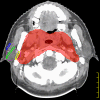A quality control method for intensity-modulated radiation therapy planning based on generalized equivalent uniform dose
- PMID: 29696777
- PMCID: PMC5978717
- DOI: 10.1002/acm2.12331
A quality control method for intensity-modulated radiation therapy planning based on generalized equivalent uniform dose
Abstract
To ensure good quality intensity-modulated radiation therapy (IMRT) planning, we proposed the use of a quality control method based on generalized equivalent uniform dose (gEUD) that predicts absorbed radiation doses in organs at risk (OAR). We conducted a retrospective analysis of patients who underwent IMRT for the treatment of cervical carcinoma, nasopharyngeal carcinoma (NPC), or non-small cell lung cancer (NSCLC). IMRT plans were randomly divided into data acquisition and data verification groups. OAR in the data acquisition group for cervical carcinoma and NPC were further classified as sub-organs at risk (sOAR). The normalized volume of sOAR and normalized gEUD (a = 1) were analyzed using multiple linear regression to establish a fitting formula. For NSCLC, the normalized intersection volume of the planning target volume (PTV) and lung, the maximum diameter of the PTV (left-right, anterior-posterior, and superior-inferior), and the normalized gEUD (a = 1) were analyzed using multiple linear regression to establish a fitting formula for the lung gEUD (a = 1). The r-squared and P values indicated that the fitting formula was a good fit. In the data verification group, IMRT plans verified the accuracy of the fitting formula, and compared the gEUD (a = 1) for each OAR between the subjective method and the gEUD-based method. In conclusion, the gEUD-based method can be used effectively for quality control and can reduce the influence of subjective factors on IMRT planning optimization.
Keywords: IMRT; gEUD; quality control; radiation planning.
© 2018 The Authors. Journal of Applied Clinical Medical Physics published by Wiley Periodicals, Inc. on behalf of American Association of Physicists in Medicine.
Figures

References
-
- Mell LK, Roeske JC, Mundt AJ, et al. A survey of intensity modulated radiation therapy use in the United States. Cancer. 2003;98:204–211. - PubMed
-
- Fang FM, Chien CY, Tsai WL, et al. Quality of life and survival outcome for patients with nasopharyngeal carcinoma receiving three‐dimensional conformal radiotherapy VS. intensity‐modulated radiotherapy‐a longitudinal study. Int J Radiat Oncol Biol Phys. 2008;72:356–364. - PubMed
-
- Wong FC, Ng AW, Lee VH, et al. Whole‐field simultaneous integrated‐boost intensity‐modulated radiotherapy for patients with nasopharyngeal carcinoma. Int J Radiat Oncol Biol Phys. 2010;76:138–145. - PubMed
-
- Roeske JC, Lujan A, Rotmensch J, et al. Intensity‐modulated whole pelvic radiation therapy in patients with gynecologic malignancies. Int J Radiat Oncol Biol Phys. 2000;48:1613–1621. - PubMed
-
- Chen MF, Tseng CJ, Tseng CC, et al. Clinical outcome in post hysterectomy cervical cancer patients treated with concurrent cisplatin and intensity‐modulated pelvic radiotherapy: comparison with conventional radiotherapy. Int J Radiat Oncol Biol Phys. 2007;67:1438–1444. - PubMed
Publication types
MeSH terms
LinkOut - more resources
Full Text Sources
Other Literature Sources
Medical

